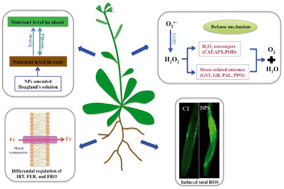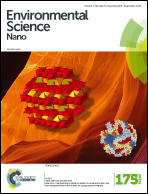Defense mechanisms and nutrient displacement in Arabidopsis thaliana upon exposure to CeO2 and In2O3 nanoparticles†
Abstract
Metal-based nanoparticles (NPs) can cause toxicity to terrestrial plants, however there is little understanding of plant defense mechanisms that may counteract nanotoxicity. In the present study, we investigated the defense mechanisms of Arabidopsis thaliana in response to 250 mg L−1 and 1000 mg L−1 cerium oxide (CeO2) and indium oxide (In2O3) NPs exposure. Excessive amounts of total reactive oxygen species (ROS) were measured upon exposure to both NPs, demonstrating clear oxidative stress in Arabidopsis. Analysis of ROS scavenger activity indicated that activities of superoxide dismutase (SOD), catalase (CAT), ascorbate peroxidase (APX), and peroxidase (POD) were significantly elevated upon exposure to CeO2 NPs, while these elevations were only evident for SOD and POD activities in the In2O3 NP treatments. In addition, the activities of glutathione S-transferase (GST) and glutathione reductase (GR) were increased by approximately 15% and 51% by 1000 mg L−1 CeO2 and In2O3 treatment, respectively. Furthermore, the activities of phenylanine ammonialyase (PAL) and polyphenol oxidase (PPO) were greatly induced in response to both types of NPs. Additionally, both NPs disrupted the uptake of elemental nutrients, as is evident from the significantly lower levels of Fe accumulation in Arabidopsis root tissues exposed to CeO2 and In2O3 NPs. These results were further supported by the differential regulation of three iron-regulating genes, including ferric chelate reductase (FRO), iron-regulated transporter (IRT) and ferritin (FER), at various time points. The findings provide useful mechanistic information for plant detoxification pathways following NP exposure.



 Please wait while we load your content...
Please wait while we load your content...